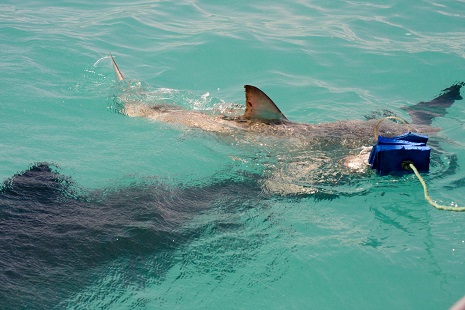"How does a mommy shark know which baby shark is hers, and for how long does a baby shark stay with its mommy?"
These two questions from seven year-old Amelia Duvenage (pictured above) from Somerset West turned out to be the most difficult questions posed to Dr Sara Andreotti during last week's Science Café Stellenbosch on great white sharks.
"I'm sorry, but we simply do not know," she had to answer.
Dr Andreotti presented the findings of her research on the population estimate of South Africa's great white sharks, while shark conservationist Michael Rutzen shared his knowledge on their social behaviour while free diving with them since 2003.
Yet neither of them could answer her question.
Dr Andreotti explains: "To date there are very few reported cases of pregnant female white sharks or their litter, and most of these reports comes from autopsies of dead specimens."
She says there exists one well-known report of a 5.15 metre long pregnant female white shark captured in a nett off Toyo in Japan in 1992. Scientists in Japan were able to obtain and study eight of its ten embryos. The results of their findings were published in the book "Great White Sharks: The biology of Carcharodon carcharias", published by Academic Press in 1996.
Based on this study and other observations, scientists can say with relative certainty that female white sharks only reach sexual maturity when they grow over 4.5 metres long. Male sharks mature at 3.6 metres.
They typically give birth to two to ten sharks pups, each of which average 1.5 metres in length at birth and weighing between 23 to 25 kilograms each. Female sharks of some other species give birth once every couple of years, but for white sharks that is still uncertain.
After more than seven years of intensive field work, sometimes living at sea for months at a time, Dr Andreotti says she has only once witnessed a smaller white shark, about 1.3 metres in length, swimming between two large white sharks, each measuring over 4 metres.
"Usually smaller-sized white sharks will swim away the moment a larger adult appears. But in this case the little one seemed content to keep close to the two adults."

In the photo above you can see the “baby” (an estimated 1.3
metres in length) above the large one (estimated length about 4.7 metres). Photo: Sara Andreotti
©Shark Diving Unlimited
While they took biopsies from all three sharks, her genetic analysis was thus far unable to pick up whether they were related or not.
"Sharks are not assumed to maintain contact with their offspring, but the truth is that we don't know if there is any kind of relationship between a mother shark and her pups or among related juveniles. They are supposed to swim off the moment they are born, but what if they form small groups to learn to hunt and other social behaviour appropriate to white sharks?"
Dr Andreotti is concerned that the current population of great white sharks along the South African coastline are mostly juveniles, and that there may not be sufficient sexually mature adults to produce the next generation.
"We need to keep this population of juveniles alive and healthy until they are mature to start reproducing," warns Dr Andreotti.
And hopefully, by that time, young Amelia Duvenage and her
generation will be able to pursue their passion for the oceans and the animals
living in it and conduct the research which will help us to understand the many
unanswered questions.
- Science Café Stellenbosch is an initiative of SU's Faculty of Science to promote the public discussion of science. Like us on Facebook to keep up to date with future events or follow us on Twitter @scicafe_SU

